Russian actress Olga Baclanova (1896-1974) achieved prominence during the silent film era and was billed as the ‘Russian Tigress’. The statuesque blonde is best known now as the trapeze artist Cleopatra in the horror classic Freaks (Tod Browning, 1932), which also features a cast of actual carnival sideshow performers.
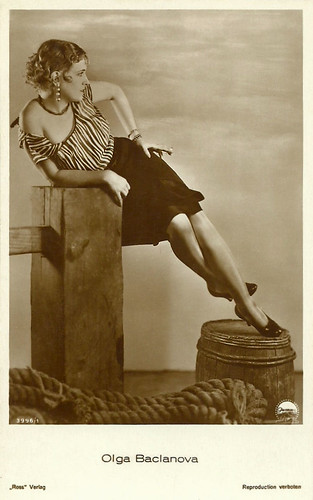
German postcard by Ross Verlag, no. 3946, 1928-1929. Photo: Paramount. Publicity still for The Docks of New York (Josef von Sternberg, 1928). Collection: Didier Hanson.
Ólga Vladímirovna Baclanova (Russian: О́льга Влади́мировна Бакла́нова) was born in Moscow in the Russian Empire in 1896. Baclanova was one of the six children of Vladimir Baclanoff and his wife Alexandra, who was an actress in early Russian films.
Baclanova studied drama at the Cherniavsky Institute before being accepted into the prestigious Moscow Art Theatre (M.A.T.) in 1912.
During her apprenticeship she would often spend the summers in the Crimea, where unbeknownst to the directors of the M.A.T., Stanislavsky and Nemirovitch-Danchenko, many students including Olga were appearing, in one- or two-reel silent films, like the Alexander Pushkin adaptation Simfoniya lyubvi i smerti/Mozart and Salieri (Viktor Tourjansky (as Viktor Turzhansky), S. Yurev, 1914), Zhenshchina vampire/The Vampire Woman (Viktor Tourjansky, 1915) and Tot, kto poluchaet poshchechiny/He Who Gets Slapped (Aleksandr Ivanov-Gai, I. Schmidt, 1916).
Her films of this period may not be totally documented, but it seems that she starred or appeared in at least a dozen and a half films, bringing her into contact with directors and actors like Viktor Tourjansky, Richard Boleslawski, Maria Ouspenskaya and Michael Chekhov.
By 1917 Olga was appearing in the M.A.T. Parent Company Productions of works by Alexander Pushkin, Anton Chekhov, Ivan Turgenev, and in the M.A.T. first studio productions of works by William Shakespeare, Charles Dickens and Ludwig Berger.
During the upheaval of the fall of the Czar, her father was murdered, and the family was confined to one room of their mansion. For sake of convenience, Olga married a lawyer named Vlademar Zoppi in 1922.
She had previously made the first communist agitprop film, Khleb/Bread (Richard Boleslawski, Boris Sushkevich, 1918) and as Paul Meienberg writes at his site dedicated to Olga Baclanova, she “knew her survival depended on her complicity with the New Regime's demands. Her mentor, Nemirovitch-Danchenko decided to form a new studio at M.A.T., the Musical Studio, which would present classical works with avant-garde staging.
Between 1920 and 1925 Olga would be the jewel around which five large-scale productions were staged. To prepare for this, she studied dance and voice with the great talents available at the M.A.T. In early 1925, Baclanova was given the highest award a Soviet artist could receive: ‘Worthy Artist of the Republic’ and she was highly praised for her contributions.”
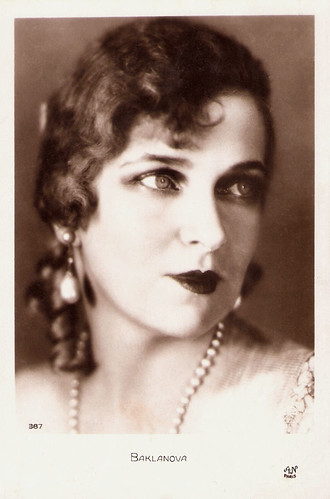
French postcard by A.N., Paris, no. 387. Photo: Paramount, 1930.
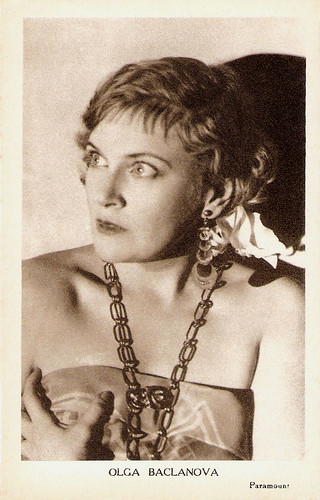
Vintage card. Photo: Paramount.
In 1925, Olga Baclanova went to New York with the 1925 touring production of the Moscow Art Theatre's Lysistrata. Though the rest of the company returned to Russia in 1926, she stayed to pursue a career in the United States.
Baclanova quickly established herself as a popular actress in American silent movies and achieved a notable success with her part as George Bancroft’s wife in Josef von Sternberg’s masterpiece, The Docks of New York (1928).
Meanwhile, Paramount cast her opposite Emil Jannings in Street of Sin (1928), the final American film of Scandinavian director Mauritz Stiller.
By the spring of 1928, Paramount offered Olga a five-year contract. That year, she appeared in another silent classic, The Man Who Laughs (Paul Leni, 1928). She played Duchess Josiana, the femme fatale love interest to Conrad Veidt's disfigured hero.
In 1929, she finally received a divorce from her first husband in Russia and she married her fiancé, Nicholas Soussanin, a Russian actor whose minor career dwindled from bits to uncredited parts over a fifteen-year period.
Olga however was a star and she was billed as the ‘Russian Tigress’. The birth of her second son was front page news in 1930.
The introduction of sound film proved difficult for Baclanova, and her stagey mannerisms and heavy Russian accent relegated her to supporting roles.
Her film career was in decline when MGM offered her the role of the evil circus performer Cleopatra in Freaks (Tod Browning, 1932). Director Browning took the exceptional step of casting real people with deformities as the eponymous sideshow ‘freaks’, rather than using costumes and makeup. The physically deformed ‘freaks’ are inherently trusting and honourable people, while the real monsters are two of the ‘normal’ circus members who conspire to murder a midget to obtain his large inheritance.
Freaks was highly controversial and screened only briefly before being withdrawn. It would be 30 years before this curious horror film gained a cult following in midnight movie screenings. Freaks did not revive Baclanova's film career.
In early 1933 she left Hollywood and her husband Soussanin behind and headed for New York. Till 1943 Boclanova starred in various Broadway productions and then toured in road companies of Cat And The Fiddle, Twentieth Century, Grand Hotel and Idiot's Delight. She debuted on the London stage in 1936 in Going Places. Baclanova also hosted a radio show in the late 1930s.
In 1939, she married Richard Davies, a Russian with an anglicised name, who owned the Fine Arts Theatre in New York. One last big role as a flamboyant, worldly opera singer in the Broadway hit Claudia kept her busy for two years (1941-1943). She returned to Hollywood in 1943 to recreate her stage role in Claudia (Edmund Goulding, 1943).
After some more summer stock and occasional night club appearances, she retired in 1948. Olga Baclanova settled in Vevey, Switzerland, where she died in a rest home in 1974.
In 1994, Freaks was selected for preservation in the United States National Film Registry as being "culturally, historically, or aesthetically significant".
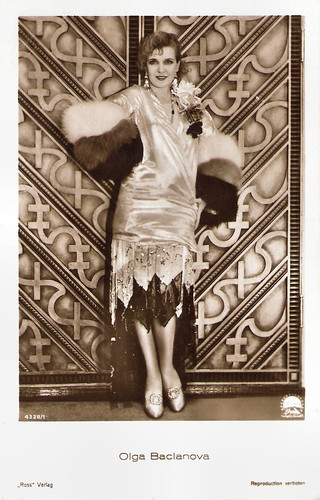
German postcard by Ross Verlag, no. 4128/1, 1929-1930. Photo: Paramount.
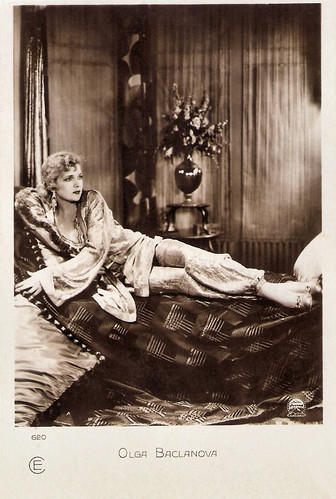
French postcard by Cinémagazine-Edition, Paris, no. 620. Photo: Paramount.
Sources: Paul Meienberg (Olga Baclanova.com), AllMovie, Wikipedia and IMDb.

German postcard by Ross Verlag, no. 3946, 1928-1929. Photo: Paramount. Publicity still for The Docks of New York (Josef von Sternberg, 1928). Collection: Didier Hanson.
Worthy Artist of the Republic
Ólga Vladímirovna Baclanova (Russian: О́льга Влади́мировна Бакла́нова) was born in Moscow in the Russian Empire in 1896. Baclanova was one of the six children of Vladimir Baclanoff and his wife Alexandra, who was an actress in early Russian films.
Baclanova studied drama at the Cherniavsky Institute before being accepted into the prestigious Moscow Art Theatre (M.A.T.) in 1912.
During her apprenticeship she would often spend the summers in the Crimea, where unbeknownst to the directors of the M.A.T., Stanislavsky and Nemirovitch-Danchenko, many students including Olga were appearing, in one- or two-reel silent films, like the Alexander Pushkin adaptation Simfoniya lyubvi i smerti/Mozart and Salieri (Viktor Tourjansky (as Viktor Turzhansky), S. Yurev, 1914), Zhenshchina vampire/The Vampire Woman (Viktor Tourjansky, 1915) and Tot, kto poluchaet poshchechiny/He Who Gets Slapped (Aleksandr Ivanov-Gai, I. Schmidt, 1916).
Her films of this period may not be totally documented, but it seems that she starred or appeared in at least a dozen and a half films, bringing her into contact with directors and actors like Viktor Tourjansky, Richard Boleslawski, Maria Ouspenskaya and Michael Chekhov.
By 1917 Olga was appearing in the M.A.T. Parent Company Productions of works by Alexander Pushkin, Anton Chekhov, Ivan Turgenev, and in the M.A.T. first studio productions of works by William Shakespeare, Charles Dickens and Ludwig Berger.
During the upheaval of the fall of the Czar, her father was murdered, and the family was confined to one room of their mansion. For sake of convenience, Olga married a lawyer named Vlademar Zoppi in 1922.
She had previously made the first communist agitprop film, Khleb/Bread (Richard Boleslawski, Boris Sushkevich, 1918) and as Paul Meienberg writes at his site dedicated to Olga Baclanova, she “knew her survival depended on her complicity with the New Regime's demands. Her mentor, Nemirovitch-Danchenko decided to form a new studio at M.A.T., the Musical Studio, which would present classical works with avant-garde staging.
Between 1920 and 1925 Olga would be the jewel around which five large-scale productions were staged. To prepare for this, she studied dance and voice with the great talents available at the M.A.T. In early 1925, Baclanova was given the highest award a Soviet artist could receive: ‘Worthy Artist of the Republic’ and she was highly praised for her contributions.”

French postcard by A.N., Paris, no. 387. Photo: Paramount, 1930.

Vintage card. Photo: Paramount.
Freaks
In 1925, Olga Baclanova went to New York with the 1925 touring production of the Moscow Art Theatre's Lysistrata. Though the rest of the company returned to Russia in 1926, she stayed to pursue a career in the United States.
Baclanova quickly established herself as a popular actress in American silent movies and achieved a notable success with her part as George Bancroft’s wife in Josef von Sternberg’s masterpiece, The Docks of New York (1928).
Meanwhile, Paramount cast her opposite Emil Jannings in Street of Sin (1928), the final American film of Scandinavian director Mauritz Stiller.
By the spring of 1928, Paramount offered Olga a five-year contract. That year, she appeared in another silent classic, The Man Who Laughs (Paul Leni, 1928). She played Duchess Josiana, the femme fatale love interest to Conrad Veidt's disfigured hero.
In 1929, she finally received a divorce from her first husband in Russia and she married her fiancé, Nicholas Soussanin, a Russian actor whose minor career dwindled from bits to uncredited parts over a fifteen-year period.
Olga however was a star and she was billed as the ‘Russian Tigress’. The birth of her second son was front page news in 1930.
The introduction of sound film proved difficult for Baclanova, and her stagey mannerisms and heavy Russian accent relegated her to supporting roles.
Her film career was in decline when MGM offered her the role of the evil circus performer Cleopatra in Freaks (Tod Browning, 1932). Director Browning took the exceptional step of casting real people with deformities as the eponymous sideshow ‘freaks’, rather than using costumes and makeup. The physically deformed ‘freaks’ are inherently trusting and honourable people, while the real monsters are two of the ‘normal’ circus members who conspire to murder a midget to obtain his large inheritance.
Freaks was highly controversial and screened only briefly before being withdrawn. It would be 30 years before this curious horror film gained a cult following in midnight movie screenings. Freaks did not revive Baclanova's film career.
In early 1933 she left Hollywood and her husband Soussanin behind and headed for New York. Till 1943 Boclanova starred in various Broadway productions and then toured in road companies of Cat And The Fiddle, Twentieth Century, Grand Hotel and Idiot's Delight. She debuted on the London stage in 1936 in Going Places. Baclanova also hosted a radio show in the late 1930s.
In 1939, she married Richard Davies, a Russian with an anglicised name, who owned the Fine Arts Theatre in New York. One last big role as a flamboyant, worldly opera singer in the Broadway hit Claudia kept her busy for two years (1941-1943). She returned to Hollywood in 1943 to recreate her stage role in Claudia (Edmund Goulding, 1943).
After some more summer stock and occasional night club appearances, she retired in 1948. Olga Baclanova settled in Vevey, Switzerland, where she died in a rest home in 1974.
In 1994, Freaks was selected for preservation in the United States National Film Registry as being "culturally, historically, or aesthetically significant".

German postcard by Ross Verlag, no. 4128/1, 1929-1930. Photo: Paramount.

French postcard by Cinémagazine-Edition, Paris, no. 620. Photo: Paramount.
Sources: Paul Meienberg (Olga Baclanova.com), AllMovie, Wikipedia and IMDb.
No comments:
Post a Comment